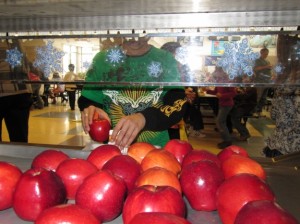Serving locally-produced foods in school meals is an important part of Farm to School, with benefits for students, communities, and farmers, alike.
Interested and involved school food service professionals, with the support of their administrators, are the cornerstones of such programs. Farmers, food distributors, Cornell Cooperative Extension professionals, teachers and parents/community members can also play important roles. Many of the resources listed below offer general guidance about incorporating local foods in school meals; specific resources for food service professionals and farmers are included in Resource sections.
For a succinct overview, see 10 Facts about Local Food in School Cafeterias by the United States Department of Agriculture.
The following steps and resources should help in developing a successful program.
Learn
Before attempting to make any changes in school meals, learn all you can about the seasonal availability of local agricultural products and how school meal programs are structured and funded.
- Review the National Farm to School Organization’s Farm to School: A Tool for Success with the New Nutrition Standards, to learn how purchasing local foods supports the new school meal pattern requirements.
- Learn how school meal programs are financed by viewing School Lunch 101 by National Farm to School Network and School Food FOCUS. Most school meals programs are expected to be self-supporting, without any additional funding from school budgets, and foods served at meals and snacks must adhere to federal nutrition standards.
- Become familiar with seasonal availability of New York produced foods by examining NYS Fruit and Vegetable Harvest Calendar by New York State Department of Agriculture and Markets and My(Northeast)Plate by NYS Department of Agriculture and Markets and Cornell Cooperative Extension.
- Find out what local foods are purchased by school districts across the county, and throughout New York State, by perusing USDA Food and Nutrition Service’s Farm to School Census and New York State Department of Agriculture and Markets’ New York State 2012 Survey of School Food Service Directors.
Collaborate
Collaborate with others to build a strong Farm to School team, by reaching out to stakeholders with different affiliations and perspectives who can make important contributions to the process. They include: food service directors, school administrators, teachers, farmers, food distributors, Cornell Cooperative Extension professionals, parents, and community members.
- See How We Started A Farm-to-Cafeteria Program and How You Can Start One, Too, by the Finger Lakes Farm to Cafeteria Program Effort, for a good overview of this process.
- See A Guide for Farm to School Community Action Planning by VT FEED, and available to download from their website, for helpful guidance about planning and implementing a Farm to School program.
Assess and Plan
Assess the current situation in your school and community and explore opportunities for involvement. Then make a plan to increase use of local foods in school meals.
- Complete the Minnesota Department of Health’s Farm to School Assessment Tool to assess your school’s current level of involvement with Farm to School.
- Contact your local office of Cornell Cooperative Extension for help in identifying any local farmers who are interested in selling directly to schools.
- Ask current food distributors what local foods they already source and whether they are able to identify these locally-sourced foods.
- Make a plan, starting with small, achievable steps. For example, as a first step, plan to feature and promote local foods on the menu during New York State’s Farm to You Fest! or during National Farm to School Month in October. Or, plan to purchase New York grown apples or potatoes throughout the year.

